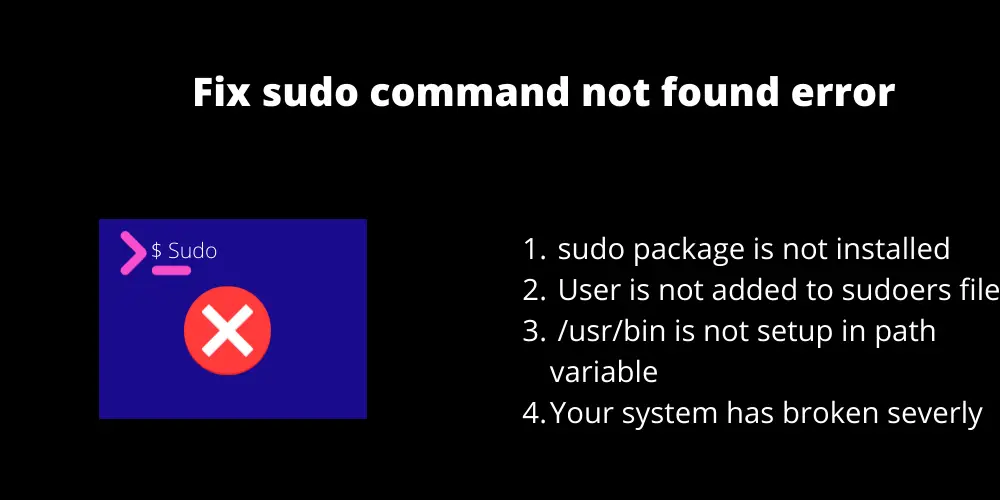

- Git sudo command not found install#
- Git sudo command not found upgrade#
- Git sudo command not found mac#
- Git sudo command not found windows#
This command will display something like this /some_directory/Python/3.9
Git sudo command not found mac#
On linux and Mac we can do it as following python3 -m site -user-base Now we have to set the path for pipenv, to do that first we have to find the user base binary directory, Pipenv -version if you see like command not found: pipenv use following commands Now check whether pipenv is showing by using following command
Git sudo command not found install#
first install pip using following command.Of course, this is specific to the user so you want to make sure you install pipenv this way while working as the user you wish to use pipenv. I could then run pipenv from the CLI and it did not overwrite the global/system-managed pip module. Then, I ran the pip install -user pipenv and all was well.

Make sure the export took effect (bit me once during this process): if it doesn't already existĮxport PYTHONUSERBASE=/home/username/.local ^ found here: Error after upgrading pip: cannot import name 'main' Sudo python3 -m pip uninstall pip & sudo apt install python3-pip -reinstall In my case, that still did not work after running the '-user' switch, so I ran the longer 'fix what I screwed up' command once to restore the system managed environment: This should install pipenv at a user-level in /home/username/.local so that it does not conflict with the global version of pip. You can install pipenv at the user level: Installing pipenv globally can have an adverse effect by overwriting the global/system-managed pip installation, thus resulting in import errors when trying to run pip.
Git sudo command not found windows#
Slow login, logoff and reboot in Windows can be caused by a large roaming profile. The roaming profile is used in Terminal Services (Remote Desktop, Citrix, etc) and when you log on / off in a corporate environment. I don't recommend install Python packages in Windows with -user, because the default user site-package directory is in your Windows roaming profile C:\Users\user\AppData\Roaming\Python\Python37\site-packages Pipenv is now available at C:\Python37\Scripts\pipenv.exe Since you don't usually share your Windows devices, it is also OK to install a package globally py -m pip install pipenv Global site packages is installed in C:\Python37\lib\site-packages The Python executable is usually named py.exe, and you can run pip with py -m pip. ~/Library/Python/3.y/lib/python/site-packagesįor legacy reasons, Python is installed in C:\Python37. Python 3.y also searches for modules in: /Library/Python/3.y/site-packages The global site-package is located at /usr/local/lib/python3.y/site-packagesĪnd you can safely install Python packages here. If you are using Homebrew'ed Python, pip install -user is disabled.
Git sudo command not found upgrade#
You can easily upgrade Python, install multiple versions of Python and switch between versions using Homebrew. On macOS, Homebrew is the recommended way to install Python. Pipenv is available at ~/.local/bin/pipenv Instead, use per-user site packages instead with -user pip3 install -user pipenv pip may be available as either of the following, depending on your Linux distribution pip3Īvoid using pip with sudo! Yes, it's the most convenient way to install Python packages and the executable is available at /usr/local/bin/pipenv, but it also mean that specific package is always visible for all users, and all Python projects that you create. The default Python 3 executable is almost always python3. On most Linux and other Unices, usually Python 2 and Python 3 is installed side-by-side. On Linux with Python 3.7 the path is usually ~/.local/lib/python3.7/site-packages You can get the path with python -m site -user-base

But the packages will still be visible to all Python projects that you create. User site-packages is where Python installs packages available only for you. You can check the global site package with the command python -m siteįor example, on Linux with Python 3.7 the path is usually /usr/lib/python3.7/dist-packages/setuptools Global site-packages is where Python installs packages that will be available to all users and all Python applications on the system. Before jumping into the command that will install pipenv, it is worth understanding where pip installs Python packages.


 0 kommentar(er)
0 kommentar(er)
